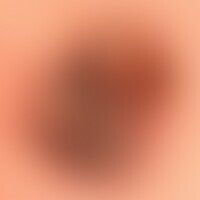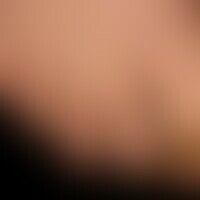Image diagnoses for "yellow"
209 results with 576 images
Results foryellow

Scleromyxoedema L98.5
Scleromyxoedema. 52-year-old patient. Continuously increasing, moderately itchy skin lesions for 5 years.

Juvenile xanthogranuloma D76.3
Xanthogranuloma, juveniles (sensu strictu): Solitary, softly elastic, yellowish, 1 x 3 cm large knot with a smooth surface on the right cheek of an infant.
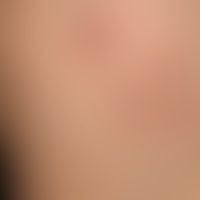
Contagious mollusc B08.1
Molluscum contagiosa: colourful picture with multiple, 0.2-0.3 cm large, yellowish, firm, shiny, sometimes itchy nodules; furthermore small scars and crusty, reddened papules (molluscs in spontaneous healing).

Contagious mollusc B08.1
Molluscum contagiosum: clinical symptoms known for months with mostly aggregated red, shiny papules up to 0.3 cm in size with typical umbilical cord of their surface; known HIV infection.
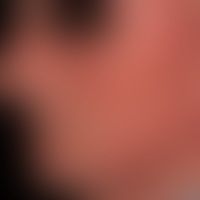
Keratosis actinica keratotic type 57.00
Keratosis actinica, keratotic type: In a 72-year-old outdoor worker, adherent keratotic plaques have increasingly developed in recent years, the mechanical detachment of which is painful, with a tendency to bleed.

Sebaceous gland hyperplasia D23.L
Sebaceous gland hyperplasia: Soft, yellowish papules which have existed for years, slowly increasing in size; in the middle of the picture 2 sebaceous cysts which are the maximum form of a sebaceous gland hyperplasia.
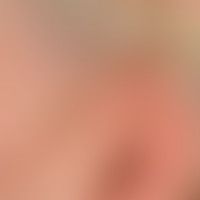
Nevus verrucosus Q82.5
naevus verrucosus. yellow-brown, verrucous plaque already present at birth. increasing verrucous component in recent years. no subjective symptoms.
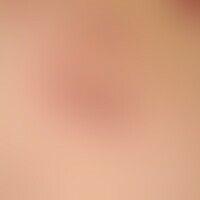
Collagenosis reactive perforating L87.1
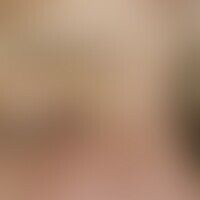
Epidermal cyst L72.0
Indolent, deeply dermal, well definable, approx. 1.0 cm large, light yellow, plump elastic node with central porus.
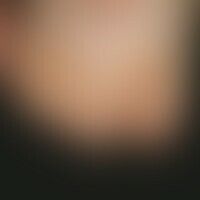
Epidermal nevus (overview) D23.L
Nevus, epidermal. (Detail)Epidermal nevus on the right foot in a 9-month-old boy. First appearance of the skin symptoms at the age of 3 months. The skin lesions are relatively uncharacteristic in terms of ocular diagnosis (flat, blurred, rough, yellowish-brownish plaques).

Keratosis palmoplantaris diffusa with mutations in KRT 9 Q82.8
Keratosis palmoplantaris diffusa circumscripta, congenital, massive, evenly distributed, waxy corneal layer in adults, no symptoms!

Yellow-nail syndrome L60.5
Yellow-nail syndrome: yellowish discolored and evenly thickened thumb nail with Beau-Reile cross-furrows.
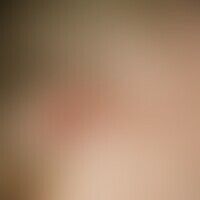
Nevus sebaceus Q82.5
Naevus sebaceus: Already at birth a completely symptomless, bizarrely configured, slightly red, waxy, always hairless spot or a corresponding plaque appeared in the neck area. The surface is slightly verrucous and irritated by excoriation. Since childhood surface growth analogous to body growth.

Pustulosis palmaris et plantaris L30.2
Pustulosis palmaris et plantaris: acutely occurring, disseminated, 0.2-0.4 cm large, smooth yellowish pustules next to older, dried brown spots; neither history nor clinical evidence of psoriasis.

Oculocutaneous tyrosinemia Q87.8

Pachyonychia congenita Q84.9
Pachyonychia congenita: congenital nail dystrophy affecting all finger and toe nails with palmoplantar keratoses: Shown here are claw-shaped, thickened and curved toenails; indicated teat pads.
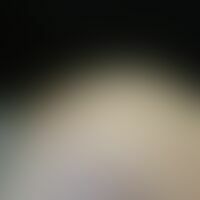
Cornu cutaneum L85
Cornu cutaneum: 73-year-old man. considerably actinic damaged skin. numerous actinic keratoses and lentigines. the narrow-based "skin horn" has existed for at least 6 months.
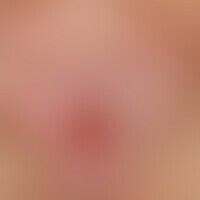
Squamous cell carcinoma of the skin C44.-
Squamous cell carcinoma of the skin, detail enlargement: since approx. 8 months increasingly growing, approx. 1 cm large, ulcerated plaque on the inner side of the left labia majora as well as extensive, whitish, atrophic plaques in the vulva area.


